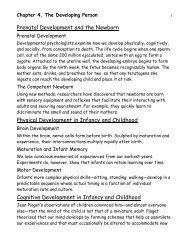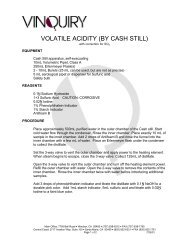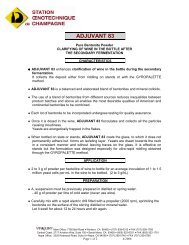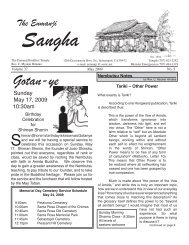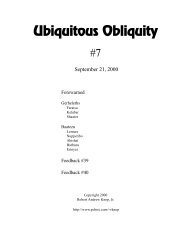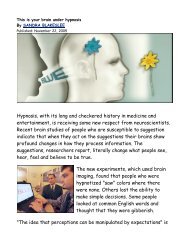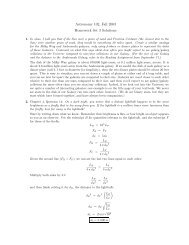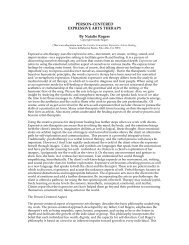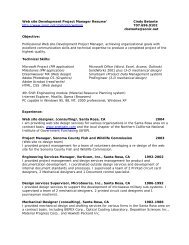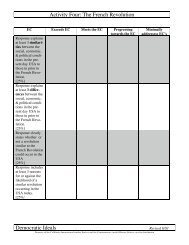“Fujiwara Tameie.” In Dictionary of Literary Biography - Sonic.net
“Fujiwara Tameie.” In Dictionary of Literary Biography - Sonic.net
“Fujiwara Tameie.” In Dictionary of Literary Biography - Sonic.net
You also want an ePaper? Increase the reach of your titles
YUMPU automatically turns print PDFs into web optimized ePapers that Google loves.
Fujiwara no <strong>Tameie</strong> DLB 203<br />
The split among Teika's pupils is perceptible at<br />
least by the time <strong>of</strong> Kawai no yashiro no uta-awase (Poem<br />
Contest at the Kawai Shrme, 1243). Designated to sit<br />
on the left for this contest were <strong>Tameie</strong>, Fujiwara no<br />
Nobuzane, Tamenori, and Hafuribe no Narishige. On<br />
the right were Tomoie, Hamuro no Mitsutoshi,<br />
Tameuji, and Fujiwara no Yukiie. All were poets <strong>of</strong><br />
considerable stature. The senior <strong>of</strong> these, Nobuzane,<br />
bad organized the contest and designated <strong>Tameie</strong> as<br />
judge as a way to bring together the various students <strong>of</strong><br />
Teika after Teika's death. The contestants on the right,<br />
however, represented the core <strong>of</strong> resistance that soon<br />
developed and lasted until <strong>Tameie</strong>'s death. That they<br />
were divided left and right in this manner probably<br />
shows that alliances were already in the making.<br />
<strong>Tameie</strong> as judge granted victory to the right, perhaps as<br />
much from humility or for political reasons as because<br />
theirs were the best poems. His judgment appears not<br />
to have helped bring the students together. Other members<br />
<strong>of</strong> this "anti-Mikohidari" group were to include<br />
Fujiwara no Motoie, Fujiwara no Ieyoshi, Rensho, and,<br />
importantly, Prince Mu<strong>net</strong>aka, first son <strong>of</strong> Emperor<br />
Go-Saga, who became sixth Kamakura shogun in 1252<br />
and made Shinkan his poetry teacher in 1260. Occasionally<br />
<strong>Tameie</strong>'s son Kyogoku Tamenori joined this<br />
resistance.<br />
<strong>In</strong> 1244 Ieyoshi, Tomoie, Nobuzane, and Mitsutoshi<br />
collaborated with <strong>Tameie</strong> to compile Shkn<br />
rokujdai waka (New Collection <strong>of</strong> Poems in Six Quires),<br />
a compendium <strong>of</strong> 2,600 poems classified by topic and<br />
designed to serve as a reference work for composing<br />
poetry. According to Gensh6 waka kuden, there was disagreement<br />
between the Tomoie/Mitsutoshi side and<br />
<strong>Tameie</strong> as to what poems should be included. <strong>In</strong> 1246<br />
Tomoie and Mitsutoshi organized a poem contest<br />
(Kasuga no wakamiya yashiro no uta-awase) that excluded<br />
<strong>Tameie</strong> and his son, indicating a clear break between<br />
the two groups. <strong>In</strong> 1247, after a poem contest sponsored<br />
by Retired Emperor Go-Saga, Rensho submitted to Go-<br />
Saga a letter criticizing <strong>Tameie</strong>'s judgments at that<br />
event.<br />
The disagreements developing at this time provide<br />
the context within which relatively different<br />
approaches to the composition <strong>of</strong> poetry developed<br />
over the next several generations. The "anti-Miiohidari"<br />
group sought more liberty in selection <strong>of</strong> subject<br />
matter, conception, and diction. They also disagreed<br />
about the corpus <strong>of</strong> works that <strong>Tameie</strong> said needed to<br />
be excluded from poetry. <strong>In</strong> general they felt Manjosh<br />
(Collection <strong>of</strong> Ten Thousand Leaves, circa 759) was an<br />
appropriate source for allusion, whereas <strong>Tameie</strong>'s tendency<br />
was for the style <strong>of</strong> poems collected in KokimhC.<br />
Mitsutoshi and <strong>Tameie</strong> were very different individuals.<br />
<strong>Tameie</strong> took a moderate, no-nonsense, some-<br />
what reserved approach to his literary activity;<br />
Mitsutoshi was more self-confident and displayed his<br />
talent more energetically. Politically, <strong>Tameie</strong> was the<br />
better situated <strong>of</strong> the two, and he had the advantage<br />
(but also the burden) <strong>of</strong> his family tradition. As the<br />
inheritor <strong>of</strong> Teika's teachings he was committed to<br />
advancing the authority <strong>of</strong> his house. He was also no<br />
doubt aware that his own talent did not equal that <strong>of</strong><br />
his father or grandfather, and perhaps this made him<br />
cautious. The Nij6 school is described as overly conservative,<br />
but this is more the result <strong>of</strong> a slow drift into<br />
imitative poetry and away from <strong>Tameie</strong>'s own calculated<br />
respect for the classics, which made sense within<br />
the terms <strong>of</strong> his own personality, philosophy, and situation.<br />
<strong>In</strong> 1248 Emperor Go-Saga commissioned the<br />
compilation <strong>of</strong> the next imperial anthology. Shoku gosenshe<br />
(1,368 poems) was completed in 1251, with<br />
<strong>Tameie</strong> its sole compiler. The selection <strong>of</strong> poems distinctly<br />
shows <strong>Tameie</strong>'s preferences for subdued compositions.<br />
The most heavily represented poets included<br />
Teika (forty-three poems), Retired Emperor Go-Toba<br />
(thirty-nine poems), Saionji no Saneuji (thirty-six<br />
poems), Yoshitsune and Shunzei (twenty-eight poems<br />
each), and Emperor Go-Saga (twenty-three poems).<br />
<strong>Tameie</strong> included eleven <strong>of</strong> his own poems.<br />
Ten years later the situation was different, showing<br />
the growth <strong>of</strong> the resistance to <strong>Tameie</strong>. Again<br />
Emperor Go-Saga sponsored the collection, and again<br />
he designated <strong>Tameie</strong> as the sole compiler. However,<br />
pressure from Prince Mu<strong>net</strong>aka, whose tutor was Mitsutoshi,<br />
persuaded Go-Saga to include as compilers<br />
Motoie, Ieyoshi, Yukiie, and Mitsutoshi-all members<br />
<strong>of</strong> the "anti-Mikohidari" group. <strong>Tameie</strong>, in his displeasure,<br />
gave almost all <strong>of</strong> the work for this collection from<br />
then on to his son Tameuji. Shoku kokinshu (Collection<br />
<strong>of</strong> Ancient and Modern Times Continued), 1,925<br />
poems, was completed in 1265. The most heavily represented<br />
poets include Mu<strong>net</strong>aka (sixty-seven poems),<br />
Saionji no Saneuji (sixty-one poems), Teika (fifty-six<br />
poems), Retired Emperor Go-Saga (fifty-four poems),<br />
Retired Emperor Go-Toba (forty-nine poems), <strong>Tameie</strong><br />
(forty-four poems), Motoie (thirty-one poems), Mitsutoshi<br />
(thirty poems), Nobuzane (twenty-eight poems),<br />
and Shunzei (twenty-seven poems).<br />
Shortly after the completion <strong>of</strong> the frst <strong>of</strong> these<br />
anthologies in 1252, the woman known as the Nun<br />
Abutsu (Ankamon'in no Shijo) arrived in Kyoto.<br />
<strong>Tameie</strong>'s love for the strong-willed Abutsu would be<br />
the starting point <strong>of</strong> the breakup <strong>of</strong> his own house into<br />
three rival groups, the Nij6, the Kyogoku, and the<br />
Reizei. Through someone Abutsu met while a nun at<br />
Nara, she was invited to work as a copyist <strong>of</strong> Genji<br />
momgatan for <strong>Tameie</strong>'s daughter, Gosaga'in Dainagon



